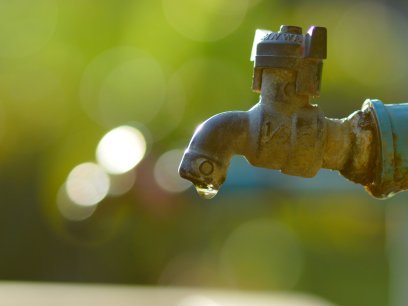Story
Household Water Use

Each day in the United States, about 27.4 billion gallons of water are withdrawn and delivered from surface water and groundwater sources for residential use, which includes water for drinking, washing clothes, flushing toilets, watering lawns, and more. Where is it all coming from?
- Water arrives at your home in one of two ways: it can come from a public supply, which is a private or public water supplier that serves at least 25 people (think of a water tower) and fulfills domestic, commercial, and industrial purposes, or it is self-supplied, which means it's likely coming from a private well.
- The majority of the water withdrawn for the public supply comes from surface water sources, such as lakes or streams, while most self-supplied domestic water use comes from groundwater sources.
- Over half of the US population relies on groundwater for domestic uses, with some states relying on groundwater especially heavily: Hawai'i, Florida, Idaho, Mississippi, Nebraska, and Iowa all used groundwater for more than 75% of their public-supply withdrawals in 2010. Help keep your water supply safe to drink: guard your groundwater and do your part to protect water quality.
- Maintain an emergency supply of drinking water in the event that your local source of water is compromised or unavailable. Ready.gov recommends keeping one gallon of commercially bottled water per family member per day, storing enough to last your family at least three days. If you have pets, be sure to have some for them as well.
- Calculate your water footprint and see if you can beat the national average by reducing your water use at home.
- For many homes, outdoor water use can be a large part of the home water budget. To help save water, try out the US EPA's WaterSense Water Budget Tool to help you plan a water-smart landscape. For more outdoor water conservation tips, check out the video below:
Sources:
- Alliance for Water Efficiency. 2015. “Home Water Works: Showers.” Accessed September 17. http://www.home-water-works.org/indoor-use/showers.
- Maupin, Molly A., Joan F. Kenny, Susan S. Hutson, John K. Lovelace, Nancy L. Barber, and Kristin S. Linsey. 2014. Estimated Use of Water in the United States in 2010. Circular 1405. Reston, Virginia: US Department of the Interior, US Geological Survey. http://dx.doi.org/10.3133/cir1405.
- National Geographic. 2015. “Water Footprint Calculator Methodology and Tips.” Accessed September 17. http://environment.nationalgeographic.com/environment/freshwater/water-calculator-methodology/.
- Ready. 2015. “Water.” Accessed September 17. http://www.ready.gov/water.
- US Census Bureau. 2010-2019. “State Population Totals and Components of Change.” Table of Annual Estimates of the Resident Population for the United States, Regions, States, and Puerto Rico: 2010-2019. Accessed April 15, 2020. https://www.census.gov/data/tables/time-series/demo/popest/2010s-state-total.html
- US EPA. 2015. “Water Trivia Facts.” Accessed September 17. http://water.epa.gov/learn/kids/drinkingwater/water_trivia_facts.cfm.
- US EPA. 2015. “WaterSense.” Accessed September 17. http://www.epa.gov/WaterSense/pubs/indoor.html.
- US Geological Survey. 2014. “Domestic Water Use.” Accessed September 17, 2015. http://water.usgs.gov/watuse/wudo.html.
- US Geological Survey. 2014. “Public Supply Water Use.” Accessed September 17, 2015. http://water.usgs.gov/watuse/wups.html.
Topics


